inflation pressure CADILLAC ESCALADE ESV 2011 Owners Manual
[x] Cancel search | Manufacturer: CADILLAC, Model Year: 2011, Model line: ESCALADE ESV, Model: CADILLAC ESCALADE ESV 2011Pages: 548, PDF Size: 8.45 MB
Page 345 of 548
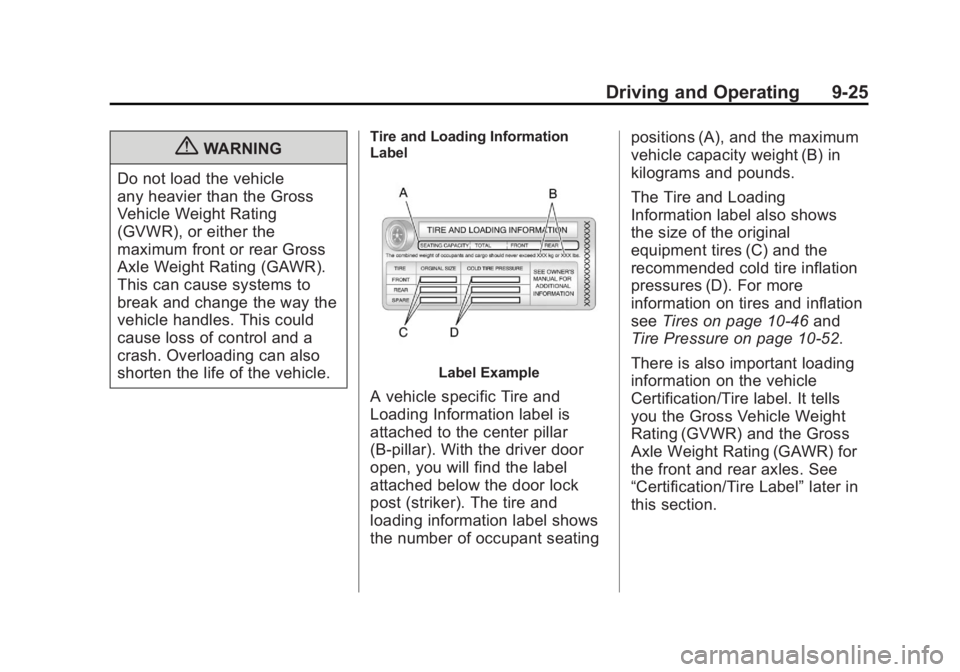
Black plate (25,1)Cadillac Escalade/Escalade ESV Owner Manual - 2011
Driving and Operating 9-25
{ WARNING
Do not load the vehicle
any heavier than the Gross
Vehicle Weight Rating
(GVWR), or either the
maximum front or rear Gross
Axle Weight Rating (GAWR).
This can cause systems to
break and change the way the
vehicle handles. This could
cause loss of control and a
crash. Overloading can also
shorten the life of the vehicle. Tire and Loading Information
Label
Label Example
A vehicle specific Tire and
Loading Information label is
attached to the center pillar
(B-pillar). With the driver door
open, you will find the label
attached below the door lock
post (striker). The tire and
loading information label shows
the number of occupant seating positions (A), and the maximum
vehicle capacity weight (B) in
kilograms and pounds.
The Tire and Loading
Information label also shows
the size of the original
equipment tires (C) and the
recommended cold tire inflation
pressures (D). For more
information on tires and inflation
see Tires on page 10 ‑ 46 and
Tire Pressure on page 10 ‑ 52 .
There is also important loading
information on the vehicle
Certification/Tire label. It tells
you the Gross Vehicle Weight
Rating (GVWR) and the Gross
Axle Weight Rating (GAWR) for
the front and rear axles. See
“ Certification/Tire Label ” later in
this section.
Page 348 of 548
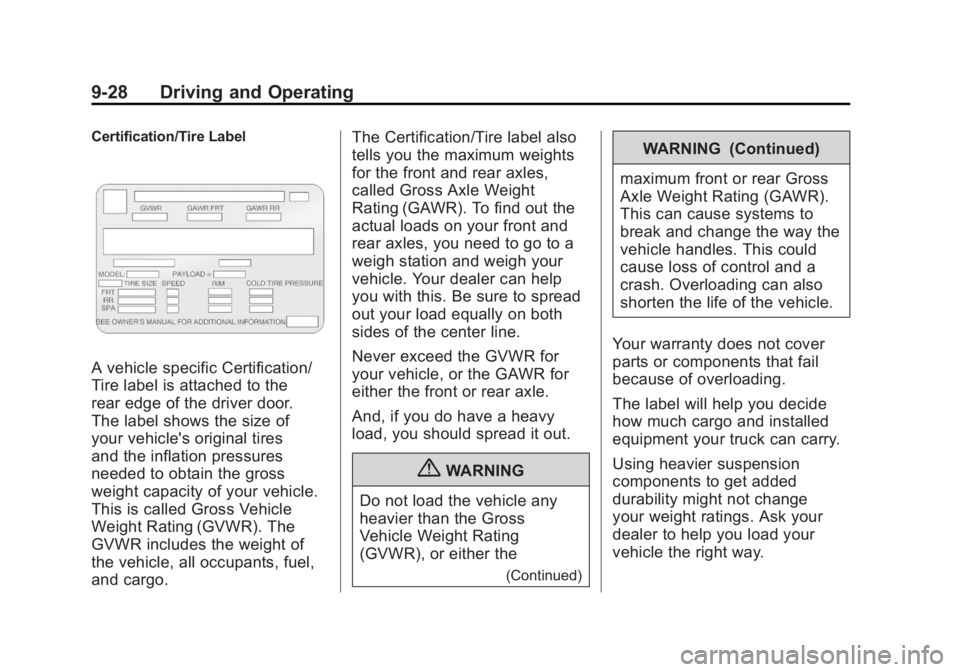
Black plate (28,1)Cadillac Escalade/Escalade ESV Owner Manual - 2011
9-28 Driving and Operating Certification/Tire Label
A vehicle specific Certification/
Tire label is attached to the
rear edge of the driver door.
The label shows the size of
your vehicle's original tires
and the inflation pressures
needed to obtain the gross
weight capacity of your vehicle.
This is called Gross Vehicle
Weight Rating (GVWR). The
GVWR includes the weight of
the vehicle, all occupants, fuel,
and cargo. The Certification/Tire label also
tells you the maximum weights
for the front and rear axles,
called Gross Axle Weight
Rating (GAWR). To find out the
actual loads on your front and
rear axles, you need to go to a
weigh station and weigh your
vehicle. Your dealer can help
you with this. Be sure to spread
out your load equally on both
sides of the center line.
Never exceed the GVWR for
your vehicle, or the GAWR for
either the front or rear axle.
And, if you do have a heavy
load, you should spread it out.
{ WARNING
Do not load the vehicle any
heavier than the Gross
Vehicle Weight Rating
(GVWR), or either the
(Continued) WARNING (Continued)
maximum front or rear Gross
Axle Weight Rating (GAWR).
This can cause systems to
break and change the way the
vehicle handles. This could
cause loss of control and a
crash. Overloading can also
shorten the life of the vehicle.
Your warranty does not cover
parts or components that fail
because of overloading.
The label will help you decide
how much cargo and installed
equipment your truck can carry.
Using heavier suspension
components to get added
durability might not change
your weight ratings. Ask your
dealer to help you load your
vehicle the right way.
Page 398 of 548
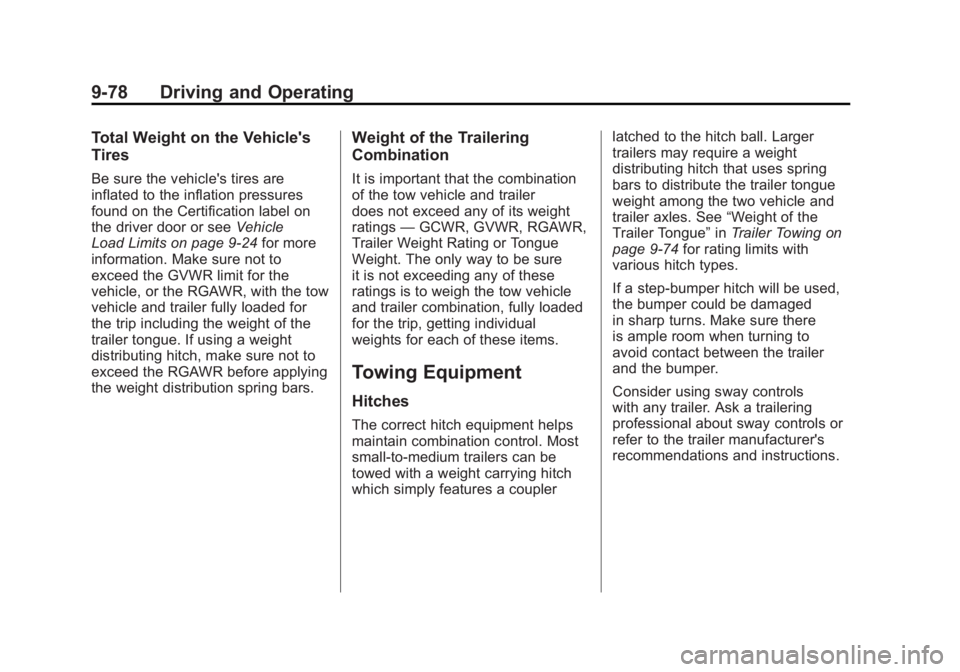
Black plate (78,1)Cadillac Escalade/Escalade ESV Owner Manual - 2011
9-78 Driving and Operating Total Weight on the Vehicle's
Tires Be sure the vehicle's tires are
inflated to the inflation pressures
found on the Certification label on
the driver door or see Vehicle
Load Limits on page 9 ‑ 24 for more
information. Make sure not to
exceed the GVWR limit for the
vehicle, or the RGAWR, with the tow
vehicle and trailer fully loaded for
the trip including the weight of the
trailer tongue. If using a weight
distributing hitch, make sure not to
exceed the RGAWR before applying
the weight distribution spring bars. Weight of the Trailering
Combination It is important that the combination
of the tow vehicle and trailer
does not exceed any of its weight
ratings — GCWR, GVWR, RGAWR,
Trailer Weight Rating or Tongue
Weight. The only way to be sure
it is not exceeding any of these
ratings is to weigh the tow vehicle
and trailer combination, fully loaded
for the trip, getting individual
weights for each of these items.
Towing Equipment Hitches The correct hitch equipment helps
maintain combination control. Most
small-to-medium trailers can be
towed with a weight carrying hitch
which simply features a coupler latched to the hitch ball. Larger
trailers may require a weight
distributing hitch that uses spring
bars to distribute the trailer tongue
weight among the two vehicle and
trailer axles. See “ Weight of the
Trailer Tongue ” in Trailer Towing on
page 9 ‑ 74 for rating limits with
various hitch types.
If a step-bumper hitch will be used,
the bumper could be damaged
in sharp turns. Make sure there
is ample room when turning to
avoid contact between the trailer
and the bumper.
Consider using sway controls
with any trailer. Ask a trailering
professional about sway controls or
refer to the trailer manufacturer's
recommendations and instructions.
Page 449 of 548
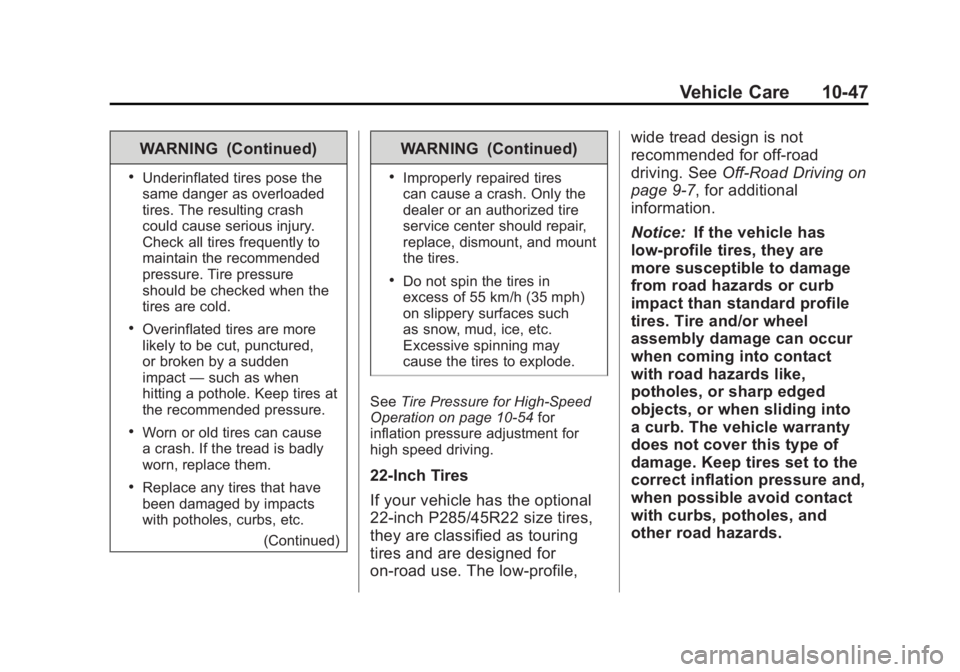
Black plate (47,1)Cadillac Escalade/Escalade ESV Owner Manual - 2011
Vehicle Care 10-47WARNING (Continued) .
Underinflated tires pose the
same danger as overloaded
tires. The resulting crash
could cause serious injury.
Check all tires frequently to
maintain the recommended
pressure. Tire pressure
should be checked when the
tires are cold. .
Overinflated tires are more
likely to be cut, punctured,
or broken by a sudden
impact — such as when
hitting a pothole. Keep tires at
the recommended pressure. .
Worn or old tires can cause
a crash. If the tread is badly
worn, replace them. .
Replace any tires that have
been damaged by impacts
with potholes, curbs, etc.
(Continued) WARNING (Continued) .
Improperly repaired tires
can cause a crash. Only the
dealer or an authorized tire
service center should repair,
replace, dismount, and mount
the tires. .
Do not spin the tires in
excess of 55 km/h (35 mph)
on slippery surfaces such
as snow, mud, ice, etc.
Excessive spinning may
cause the tires to explode.
See Tire Pressure for High-Speed
Operation on page 10 ‑ 54 for
inflation pressure adjustment for
high speed driving.
22 ‐ Inch Tires
If your vehicle has the optional
22 ‐ inch P285/45R22 size tires,
they are classified as touring
tires and are designed for
on ‐ road use. The low ‐ profile, wide tread design is not
recommended for off ‐ road
driving. See Off-Road Driving on
page 9 ‑ 7 , for additional
information.
Notice: If the vehicle has
low ‐ profile tires, they are
more susceptible to damage
from road hazards or curb
impact than standard profile
tires. Tire and/or wheel
assembly damage can occur
when coming into contact
with road hazards like,
potholes, or sharp edged
objects, or when sliding into
a curb. The vehicle warranty
does not cover this type of
damage. Keep tires set to the
correct inflation pressure and,
when possible avoid contact
with curbs, potholes, and
other road hazards.
Page 451 of 548

Black plate (49,1)Cadillac Escalade/Escalade ESV Owner Manual - 2011
Vehicle Care 10-49(G) Maximum Cold Inflation
Load Limit :
Maximum load
that can be carried and the
maximum pressure needed
to support that load. For
information on recommended
tire pressure see Tire Pressure
on page 10 ‑ 52 and Vehicle Load
Limits on page 9 ‑ 24 .
Tire Designations Tire Size
The following examples show
the different parts of a tire size.
Passenger (P ‐ Metric) Tire
(A) Passenger (P ‐ Metric) Tire :
The United States version of a
metric tire sizing system. The
letter P as the first character in the tire size means a passenger
vehicle tire engineered to
standards set by the U.S. Tire
and Rim Association.
(B) Tire Width :
The three ‐ digit
number indicates the tire section
width in millimeters from
sidewall to sidewall.
(C) Aspect Ratio :
A two ‐ digit
number that indicates the tire
height ‐ to ‐ width measurements.
For example, if the tire size
aspect ratio is 75, as shown
in item C of the light truck
(LT ‐ Metric) tire illustration, it
would mean that the tire's
sidewall is 75% as high as it
is wide.
(D) Construction Code :
A
letter code is used to indicate
the type of ply construction in
the tire. The letter R means
radial ply construction; the
letter D means diagonal or bias ply construction; and the
letter B means belted ‐ bias ply
construction.
(E) Rim Diameter :
Diameter of
the wheel in inches.
(F) Service Description :
These
characters represent the load
index and speed rating of the
tire. The load index represents
the load carrying capacity a tire
is certified to carry. The speed
rating is the maximum speed a
tire is certified to carry a load.
Tire Terminology and
Definitions Air Pressure :
The amount
of air inside the tire pressing
outward on each square inch
of the tire. Air pressure is
expressed in kPa (kilopascal)
or psi (pounds per square inch).
Page 453 of 548

Black plate (51,1)Cadillac Escalade/Escalade ESV Owner Manual - 2011
Vehicle Care 10-51Load Index :
An assigned
number ranging from 1 to 279
that corresponds to the load
carrying capacity of a tire.
Maximum Inflation Pressure :
The maximum air pressure to
which a cold tire can be inflated.
The maximum air pressure is
molded onto the sidewall.
Maximum Load Rating :
The
load rating for a tire at the
maximum permissible inflation
pressure for that tire.
Maximum Loaded Vehicle
Weight :
The sum of curb
weight, accessory weight,
vehicle capacity weight, and
production options weight.
Normal Occupant Weight :
The
number of occupants a vehicle
is designed to seat multiplied by
68 kg (150 lbs). See Vehicle
Load Limits on page 9 ‑ 24 . Occupant Distribution :
Designated seating positions.
Outward Facing Sidewall :
The
side of an asymmetrical tire that
has a particular side that faces
outward when mounted on a
vehicle. The side of the tire
that contains a whitewall,
bears white lettering, or bears
manufacturer, brand, and/or
model name molding that is
higher or deeper than the same
moldings on the other sidewall
of the tire.
Passenger (P-Metric) Tire :
A
tire used on passenger cars
and some light duty trucks and
multipurpose vehicles.
Recommended Inflation
Pressure :
Vehicle
manufacturer's recommended
tire inflation pressure as shown
on the tire placard. See Tire Pressure on page 9 ‑ 24
and Vehicle Load Limits on
page 9 ‑ 24 .
Radial Ply Tire :
A pneumatic
tire in which the ply cords that
extend to the beads are laid at
90 degrees to the centerline of
the tread.
Rim :
A metal support for a tire
and upon which the tire beads
are seated.
Sidewall :
The portion of a tire
between the tread and the bead.
Speed Rating :
An
alphanumeric code assigned to
a tire indicating the maximum
speed at which a tire can
operate.
Traction :
The friction between
the tire and the road surface.
The amount of grip provided.
Tread :
The portion of a tire
that comes into contact with
the road.
Page 454 of 548
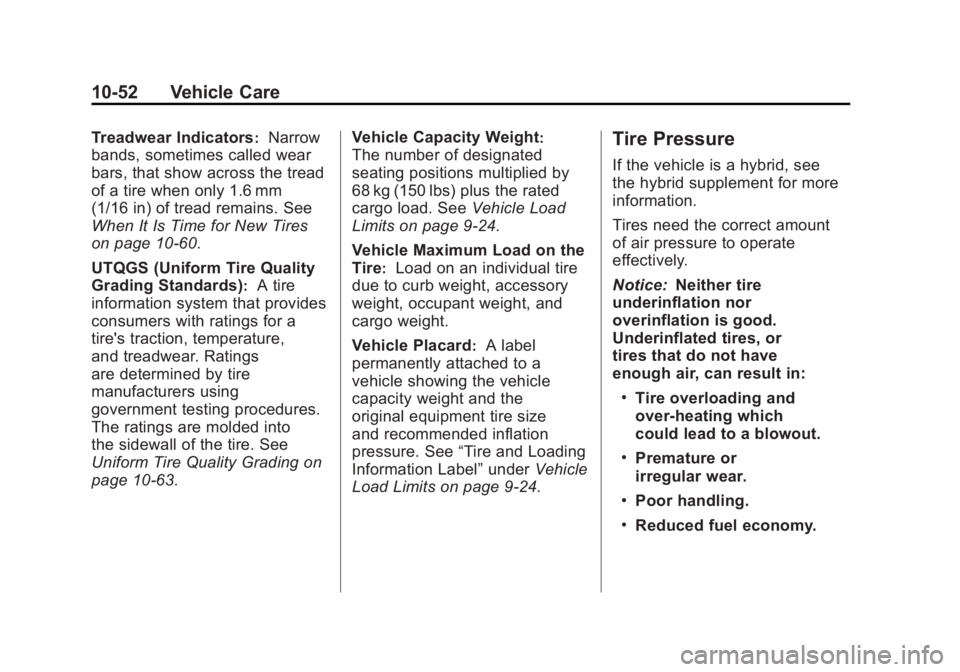
Black plate (52,1)Cadillac Escalade/Escalade ESV Owner Manual - 2011
10-52 Vehicle Care Treadwear Indicators :
Narrow
bands, sometimes called wear
bars, that show across the tread
of a tire when only 1.6 mm
(1/16 in) of tread remains. See
When It Is Time for New Tires
on page 10 ‑ 60 .
UTQGS (Uniform Tire Quality
Grading Standards) :
A tire
information system that provides
consumers with ratings for a
tire's traction, temperature,
and treadwear. Ratings
are determined by tire
manufacturers using
government testing procedures.
The ratings are molded into
the sidewall of the tire. See
Uniform Tire Quality Grading on
page 10 ‑ 63 . Vehicle Capacity Weight :
The number of designated
seating positions multiplied by
68 kg (150 lbs) plus the rated
cargo load. See Vehicle Load
Limits on page 9 ‑ 24 .
Vehicle Maximum Load on the
Tire :
Load on an individual tire
due to curb weight, accessory
weight, occupant weight, and
cargo weight.
Vehicle Placard :
A label
permanently attached to a
vehicle showing the vehicle
capacity weight and the
original equipment tire size
and recommended inflation
pressure. See “ Tire and Loading
Information Label ” under Vehicle
Load Limits on page 9 ‑ 24 .Tire Pressure If the vehicle is a hybrid, see
the hybrid supplement for more
information.
Tires need the correct amount
of air pressure to operate
effectively.
Notice: Neither tire
underinflation nor
overinflation is good.
Underinflated tires, or
tires that do not have
enough air, can result in: .
Tire overloading and
over-heating which
could lead to a blowout. .
Premature or
irregular wear. .
Poor handling. .
Reduced fuel economy.
Page 455 of 548
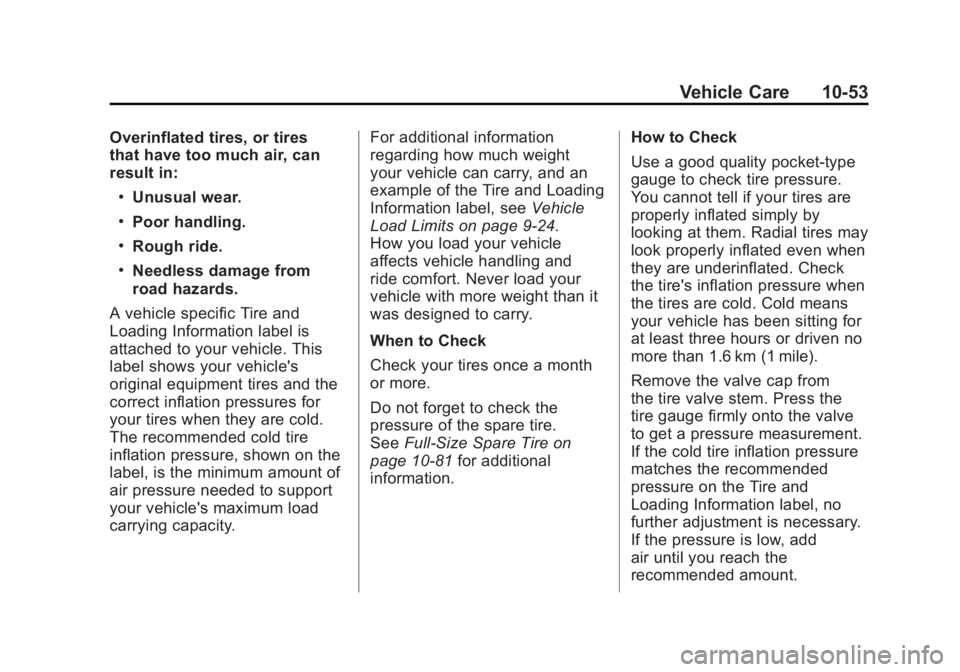
Black plate (53,1)Cadillac Escalade/Escalade ESV Owner Manual - 2011
Vehicle Care 10-53Overinflated tires, or tires
that have too much air, can
result in: .
Unusual wear. .
Poor handling. .
Rough ride. .
Needless damage from
road hazards.
A vehicle specific Tire and
Loading Information label is
attached to your vehicle. This
label shows your vehicle's
original equipment tires and the
correct inflation pressures for
your tires when they are cold.
The recommended cold tire
inflation pressure, shown on the
label, is the minimum amount of
air pressure needed to support
your vehicle's maximum load
carrying capacity. For additional information
regarding how much weight
your vehicle can carry, and an
example of the Tire and Loading
Information label, see Vehicle
Load Limits on page 9 ‑ 24 .
How you load your vehicle
affects vehicle handling and
ride comfort. Never load your
vehicle with more weight than it
was designed to carry.
When to Check
Check your tires once a month
or more.
Do not forget to check the
pressure of the spare tire.
See Full-Size Spare Tire on
page 10 ‑ 81 for additional
information. How to Check
Use a good quality pocket-type
gauge to check tire pressure.
You cannot tell if your tires are
properly inflated simply by
looking at them. Radial tires may
look properly inflated even when
they are underinflated. Check
the tire's inflation pressure when
the tires are cold. Cold means
your vehicle has been sitting for
at least three hours or driven no
more than 1.6 km (1 mile).
Remove the valve cap from
the tire valve stem. Press the
tire gauge firmly onto the valve
to get a pressure measurement.
If the cold tire inflation pressure
matches the recommended
pressure on the Tire and
Loading Information label, no
further adjustment is necessary.
If the pressure is low, add
air until you reach the
recommended amount.
Page 456 of 548

Black plate (54,1)Cadillac Escalade/Escalade ESV Owner Manual - 2011
10-54 Vehicle Care If you overfill the tire, release air
by pushing on the metal stem
in the center of the tire valve.
Recheck the tire pressure with
the tire gauge.
Be sure to put the valve caps
back on the valve stems. They
help prevent leaks by keeping
out dirt and moisture.
Tire Pressure for
High-Speed Operation
{ WARNING
Driving at high speeds, 160 km/h
(100 mph) or higher, puts an
additional strain on tires.
Sustained high-speed driving
causes excessive heat build up
and can cause sudden tire failure.
You could have a crash and you
or others could be killed. Some
high-speed rated tires require
(Continued) WARNING (Continued) inflation pressure adjustment for
high speed operation. When
speed limits and road conditions
are such that a vehicle can be
driven at high speeds, make sure
the tires are rated for high speed
operation, in excellent condition,
and set to the correct cold tire
inflation pressure for the
vehicle load.
If your vehicle has P265/65R18 or
P285/45R22 size tires and you will
be driving at high speeds, speeds of
160 km/h (100 mph) or higher, set
the cold inflation pressure to 20 kPa
(3 psi) above the recommended tire
pressure shown on the Tire and
Loading Information Label. When
you end this high ‐ speed driving,
return the tires to the cold inflation
pressure shown on the Tire and
Loading Information label. See
Vehicle Load Limits on page 9 ‑ 24
and Tire Pressure on page 10 ‑ 52 .Tire Pressure Monitor
System The Tire Pressure Monitor System
(TPMS) uses radio and sensor
technology to check tire pressure
levels. The TPMS sensors monitor
the air pressure in your tires and
transmit tire pressure readings to a
receiver located in the vehicle.
Each tire, including the spare
(if provided), should be checked
monthly when cold and inflated to
the inflation pressure recommended
by the vehicle manufacturer on
the vehicle placard or tire inflation
pressure label. (If your vehicle has
tires of a different size than the size
indicated on the vehicle placard or
tire inflation pressure label, you
should determine the proper tire
inflation pressure for those tires.)
Page 457 of 548

Black plate (55,1)Cadillac Escalade/Escalade ESV Owner Manual - 2011
Vehicle Care 10-55As an added safety feature, your
vehicle has been equipped with a
tire pressure monitoring system
(TPMS) that illuminates a low tire
pressure telltale when one or
more of your tires is significantly
under ‐ inflated.
Accordingly, when the low tire
pressure telltale illuminates, you
should stop and check your tires as
soon as possible, and inflate them
to the proper pressure. Driving on
a significantly under ‐ inflated tire
causes the tire to overheat and can
lead to tire failure. Under ‐ inflation
also reduces fuel efficiency and
tire tread life, and may affect the
vehicle's handling and stopping
ability.
Please note that the TPMS is
not a substitute for proper tire
maintenance, and it is the driver's
responsibility to maintain correct
tire pressure, even if under ‐ inflation
has not reached the level to trigger
illumination of the TPMS low tire
pressure telltale. Your vehicle has also been
equipped with a TPMS malfunction
indicator to indicate when the
system is not operating properly.
The TPMS malfunction indicator is
combined with the low tire pressure
telltale. When the system detects a
malfunction, the telltale will flash for
approximately one minute and then
remain continuously illuminated.
This sequence will continue upon
subsequent vehicle start ‐ ups as
long as the malfunction exists.
When the malfunction indicator is
illuminated, the system may not be
able to detect or signal low tire
pressure as intended. TPMS
malfunctions may occur for a variety
of reasons, including the installation
of replacement or alternate tires or
wheels on the vehicle that prevent
the TPMS from functioning properly. Always check the TPMS malfunction
telltale after replacing one or more
tires or wheels on your vehicle to
ensure that the replacement or
alternate tires and wheels allow
the TPMS to continue to function
properly.
See Tire Pressure Monitor
Operation on page 10 ‑ 56 for
additional information.
Federal Communications
Commission (FCC) and
Industry Canada See Radio Frequency Statement on
page 13 ‑ 19 for information
regarding Part 15 of the Federal
Communications Commission (FCC)
rules and Industry Canada
Standards RSS-210/220/310.